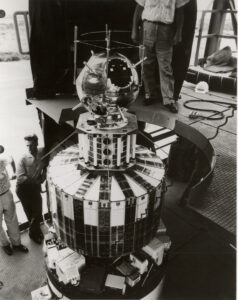Introduction
Everyone in deep black space is interested in exploring a new era that is unfolding with the revolutions of small satellites, also referred to as smallest’s. These small wonders weigh less than 1200, transforming the satellite industries. But what makes these lightweight marvels so essential, and why are they gaining more significance? Let’s explore the reasons behind the growing importance of these compact space innovations.

Why miniaturization (making small satellite) is Important
Boosting Economic Efficiency
The main drive behind making satellites smaller is to cut costs. Traditional, heavier satellites need larger and more powerful rockets, leading to higher launch expenses. On the other side, smaller satellites require more affordable launch vehicles, sometimes allowing for multiple satellites to be sent up in a single mission or even hitching a ride on larger launches.
Mission Versatility
The small ones come with a distinct advantage, making it possible to tackle missions that might be difficult for their larger counterparts. Some key applications include:
1. Low Data Rate Communication Constellations: Small satellites contribute to forming constellations for low data rate communications, enhancing global connectivity.
2. Formation Flying: Using formations of smallest’s enables data gathering from multiple points, providing a comprehensive view of targeted areas.
3. In-Orbit Inspection: Small satellites facilitate in-orbit inspection of larger satellites, contributing to maintenance and operational efficiency.
4. University Research: They provide an accessible platform for university-related research, allowing students and researchers to engage in space exploration.
5. Hardware Testing: Small satellites are ideal for testing and qualifying new hardware before deploying it on more expensive spacecraft.
Satellite Size Categories
To grasp the variety of small satellites, we classify them based on their mass. The categories range from Pico satellites, weighing 0.1 to 1 kg, to Extra Heavy satellites, surpassing 7,000 kg.
- Pico Satellite: 0.1 to 1 kg
- Nano Satellite: 1.1 to 10 kg
- Micro Satellite: 11 to 200 kg
- Mini Satellite: 201 to 600 kg
- Small Satellite: 601 to 1,200 kg
Exploring the History of Small Satellites
The Genesis of Small Satellites

The story of small satellites, or smallest’s, began with humble yet groundbreaking initiatives. The first foray into space by a small satellite was the Soviet Union’s launch of Sputnik 1 on October 4, 1957. Although not considered small by today’s standards, the success of Sputnik 1 paved the way for the development of smaller and more cost-effective spacecraft.
The Vanguard Program and Early Setbacks

(Image Credit : Nasa)

(Image Credit : Nasa)
In response to the Soviet achievement, the United States launched the Vanguard program to create its own satellite. However, the first attempt, Vanguard TV3, faced a setback when it exploded on the launch pad on December 6, 1957. The successful launch of Explorer 1 on January 31, 1958, marked the United States’ entry into the space race.
The Era of Miniaturization

(Image Credit : Nasa)
The 1960s and 1970s witnessed advancements in miniaturization technologies, enabling the creation of smaller satellites. In 1961, the United States launched Transit 4A, the first scientific satellite designed for experiments. Its success highlighted the potential of miniaturized payloads in specific scientific applications.
Emergence of Communication Satellites

(Image Credit : Nasa)
As technology advanced, small satellites found applications beyond scientific research. In the 1970s, the United States launched the Applications Technology Satellite (ATS-6), a key player in advancing satellite communication capabilities. This signaled a shift towards smaller, more specialized satellites.
The Advent of CubeSats
The early 2000s marked a milestone with the development of CubeSats. Introduced by California Polytechnic State University and Stanford University in 1999, CubeSats standardized small satellite dimensions, making them more accessible to educational institutions and private entities.
Chandrayaan-1: India’s Lunar Exploration Triumph
In 2008, India made history with the successful launch of Chandrayaan-1, its first lunar probe. Chandrayaan-1 marked a significant milestone for small satellite technology, showcasing India’s capabilities in space exploration and contributing valuable data to our understanding of the Moon.
Global Adoption and Proliferation
While the Soviet Union and the United States led the initial space race, other nations quickly embraced small satellite technology. Europe, through the European Space Agency (ESA), actively contributed to small satellite development. In 2003, ESA launched its first Earth observation microsatellite, Proba-1.
Asian countries, including China and India, have made significant strides in small satellite technology. China launched its first research satellite, Shijian-6, in 2004, showcasing its capabilities in space exploration. India, with the successful Chandrayaan-1 mission in 2008, demonstrated the potential of small satellites for lunar exploration.
Current Landscape and Global Players
In recent years, numerous countries have adopted small satellite technology for various missions. The United States, with a thriving private space industry, has seen the rise of companies like SpaceX, Rocket Lab, and Virgin Orbit, offering dedicated launch services for the smallest’s.
European nations continue to contribute to the small satellite landscape with initiatives like the Vega rocket program by the European Space Agency.
Asian countries, including Japan and South Korea, have launched small satellites for Earth observation and scientific research. Japan’s TSUBAME, launched in 2017, exemplifies the country’s commitment to advanced Earth observation capabilities.
Challenges and Future Outlook
As the small satellite industry evolves, challenges such as power storage limitations and propulsion constraints persist. However, ongoing advancements in technology, including miniaturized propulsion systems and improved power efficiency, hold the promise of overcoming these challenges.
The historical journey of small satellites reflects global collaboration, with nations contributing to space exploration in innovative and cost-effective ways. As technology advances and launches become more accessible, the era of small satellites is poised to play an increasingly vital role in shaping the future of space exploration.
Following are a few notable small satellites from different countries.
| Satellite Name | Launch Date | Country of Launch |
|---|---|---|
| Sputnik 1 | Oct 4, 1957 | Soviet Union |
| Explorer 1 | Jan 31, 1958 | United States |
| ATS-6 | May 30, 1974 | United States |
| Proba-1 | Oct 22, 2001 | European Space Agency (ESA) |
| Shijian-6 | Oct 19, 2004 | China |
| Chandrayaan-1 | Oct 22, 2008 | India |
| CubeSat XI-IV | Nov 20, 2013 | Japan |
| TSUBAME | Dec 23, 2017 | Japan |
| FalconSAT-3 | March 9, 2007 | United States |
| ZACUBE-1 | Dec 23, 2013 | South Africa |